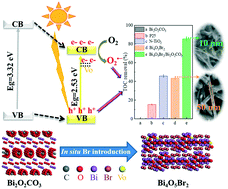Ultrathin Bi4O5Br2 nanosheets with surface oxygen vacancies and strong interaction with Bi2O2CO3 for highly efficient removal of water contaminants†
Abstract
Ultrathin Bi4O5Br2 nanosheets with about a 10 nm thickness were synthesized by in situ intergrowth with Bi2O2CO3 sheets at room temperature. The degradation rates of organic pollutants on the catalyst were 28.1, 9.5, and 8.5 times higher than those on P25, N-TiO2 and 50 nm thick Bi4O5Br2 under a visible LED. The supreme catalytic activity was confirmed to be due to the significantly enhanced charge separation and transfer by surface oxygen vacancies on the ultrathin nanosheets, and the facilitated adsorption–degradation process at the solid–liquid micro-interface. The photogenerated electrons were demonstrated to be trapped on surface OVs to reduce surface adsorbed O2 into O2˙−. Meanwhile, the photogenerated holes were effectively utilized to directly oxidize organic pollutants at the catalyst surface. FTIR, HPLC-Q-TOF-MS and IC analysis confirmed that diclofenac (DCF) was degraded at the catalyst surface through decarboxylation, dechloridation and C–N cleavage, and further mineralized in reaction solution. In addition, the developed catalyst can work at different pH values (5–10) and was stable after eight reaction cycles, showing good potential in practical application.

- This article is part of the themed collection: Nanomaterial applications in water


 Please wait while we load your content...
Please wait while we load your content...